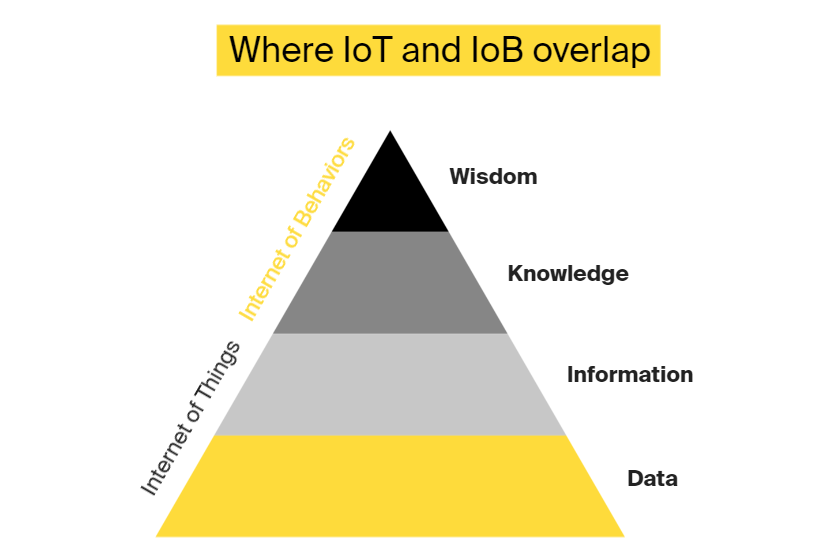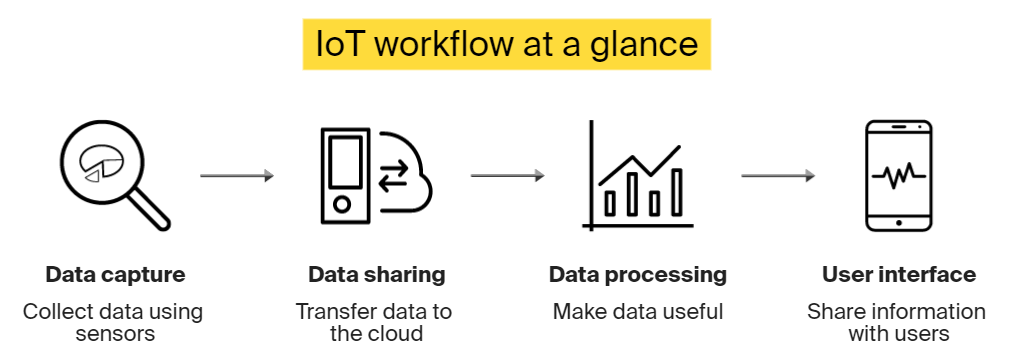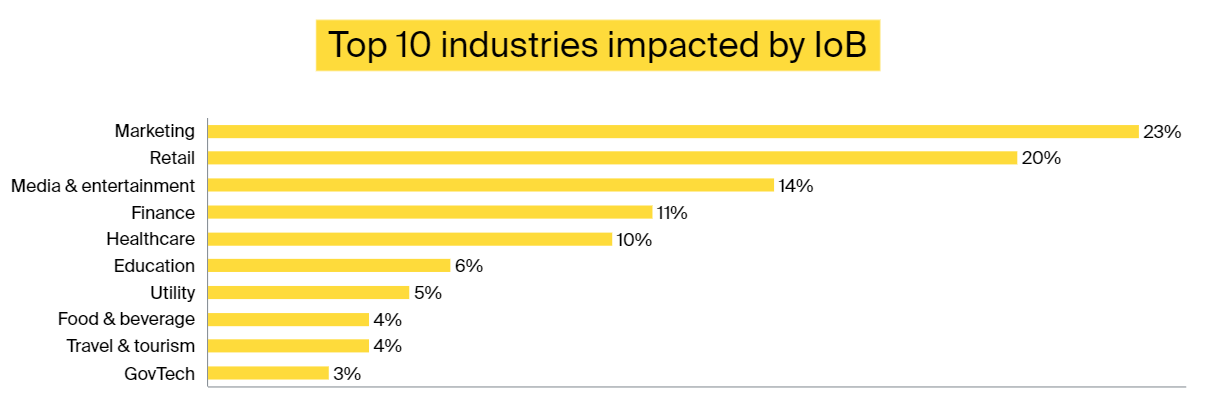What is the Internet of Behaviors (IoB), and how can it support your business?
Internet of Behaviors platforms aggregate data from different sources, such as IoT sensors, social media, online stores, etc. This data is analyzed in light of behavioral psychology to discover behavior patterns. Companies can use those to influence consumer behavior, create new products, and craft more effective marketing campaigns.
Simply put, the Internet of Behaviors field aims to understand when, why, and how people perform a certain task. Let’s draw a parallel with eCommerce. Essentially, IoB does what web analytics tools like Google Analytics, Ahrefs, and Lucky Orange do — i.e., figure out what website pages users visit, how long they stay on a particular page, and how they interact with its content.
Only the Internet of Behaviors takes the concept even further by gathering and processing data from more sources, such as movement sensors mounted to store shelves, smart CCTV cameras scattered around a shopping mall, or fitness trackers your potential customers wear on a morning run.
You might be wondering, given that the Internet of Behaviors uses data from different sources, whether it is identical to the Internet of Things (IoT) concept and, if not, what it does differently.
IoT can be regarded as the foundation for IoB as IoT sensors gather data that the Internet of Behaviors enriches and processes further.
Also, be careful not to confuse the Internet of Behaviors with another concept with the same abbreviation — the Internet of Bodies. You can learn more about this concept on our blog.
Technologies driving the Internet of Behaviors
The Internet of Behaviors combines different technologies, like the above-mentioned IoT, as well as AI, data analytics, and cloud computing, with behavioral science.

The Internet of Things (IoT)
McKinsey defines the Internet of Things as a network of physical objects containing sensors and actuators. They communicate with each other and/or a central processing unit, as well as cloud-based or on-premises servers, via a wired or wireless connection, allowing the central hub to monitor and even control objects within an IoT deployment.
IoT devices capture and analyze user data, and present it in a convenient format.
So, IoT supplies a large portion of consumer data, while IoB adds other types of data, such as geo-tagging, purchase transactions, social media activities, and more, and uses AI and data analytics to interpret and structure this information. Then the Internet of Behaviors relies on behavioral science and, again, artificial intelligence, to grasp how users act. Finally, it deploys this knowledge to sway user behavior in the desired direction.
Artificial intelligence (AI)
AI refers to smart algorithms that can reason like humans, make decisions, and perform activities that are believed to require a human level of intelligence. For more information on AI and its subtypes, you can refer to our blog.
The Internet of Behaviors uses AI to spot and analyze different behavioral patterns in consumer data. For instance, in a recent study, researchers experimented with IoB and explainable AI to understand electrical power consumption patterns among users and deploy this information to bring power utilization down. This system allowed researchers to decrease the energy consumption by 522.2 kW over a period of 200 hours.
Big data analytics
This technology is essential if you want to work with large volumes of structured, semi-structured, unstructured, and otherwise complex data, where the traditional approaches to data handling wouldn’t suffice.
IoT, which supplies data to the Internet of Behaviors platforms, is a major source of big data. So, if you want to work with IoT, you will need big data analytics for efficient data management. These tools also include dashboards and other data visualization solutions presenting information in a visually appealing and comprehensible format.
The Internet of Behaviors data analysis can be integrated into enterprise software, such as ERP or CRM.
To learn more about how this technology can benefit your company, check out our recent article on big data and its business impact.
Cloud computing
Cloud computing means on-demand access to computing resources through the Internet. This includes hardware resources, such as servers and data storage units, and software assets, like apps, development tools, etc. All these are hosted remotely and managed by a cloud service provider.
Cloud computing allows companies to access resources with pay-as-you-go pricing models without the need to purchase and locally install all the infrastructure. This drastically minimizes the initial investment and allows companies to scale without worrying about purchasing more equipment. For more information on this topic, check out this article on cloud computing in healthcare.
When building the Internet of Behavior platforms, companies will need large data storage units, powerful analytical capabilities, and more. It would be rather expensive to install and maintain such infrastructure locally. Using cloud computing will give you access to virtual resources and allow you to pay based on usage.
Behavioral science
Behavioral science is a discipline that studies human behavior through experimentation and observation. It aims to explain why people act in a certain way.
Within the context of the Internet of Behaviors, this field of study helps businesses understand why people buy certain products, how they interact with websites, and more. Behavioral science considers multiple factors, such as motivation, habits, social influence, etc., to figure out the rationale behind human actions.
Benefits of implementing the Internet of Behaviors
The Internet of Behaviors helps companies make sense of large quantities of data gathered from different sources and monetize it or use it to improve operations, services, and products.
Here is what businesses can get from deploying the Internet of Behaviors:
-
Gain access to consumers’ buying behavior across different platforms, not limited by their online store
-
Understand how customers interact with their devices (e.g., laptops, smartphones, etc.) to offer a better shopping experience
-
Test different marketing campaigns to see how users engage with them
-
Monitor the sales team’s performance and suggest modifications to achieve higher conversion rates
-
Create a better user experience based on understanding people’s needs
-
Gauge the demand for different products to avoid overstocking or running out of supplies
-
Offer customized product recommendations
-
Provide targeting ads in physical stores thanks to location-based data
Examples of the Internet of Behaviors in different sectors
Studies show that the Internet of Behaviors has the biggest impact on marketing and retail, followed by entertainment, finances, healthcare, and education. Let’s see how the technology can transform these industries.
Please note that marketing is not included below because it spans several sectors.
The Internet of Behaviors in retail
The Internet of Behaviors, combined with AI, can help understand what each consumer likes and needs from their browsing history, stats from physical stores, voice assistant search queries, and more, and only recommend products and services that are relevant to that person. This information also helps craft customized marketing campaigns.
You can also tune your settings to capture customer feedback from Google surveys. For instance, when users are asked to review a particular restaurant, you can understand what type of food this person likes and which atmosphere they prefer.
There are ready-made solutions that you can integrate into your online store to analyze consumer behavior. One example is Sweet Analytics. This London-based startup built a powerful user data platform that deploys machine learning to gauge customer behavior, engagement patterns, and preferences. It pulls data from different sources, including Google, Shopify, etc. to provide a unified image of each customer. With this knowledge, you can direct your marketing efforts to the right person at the right time with the right content.
There are IoB tools that can benefit physical stores as well. For instance, Żabka Nano convenience stores use self-checkout systems facilitated by AI-powered cameras and a dedicated mobile app. To shop at these stores, consumers need to connect a bank card to the Zabka app and generate a QR code and scan it every time they enter a Nano store.
You don’t have to queue to pay for the groceries. Cameras positioned on the shelves identify the products that you took and the corresponding amount is deducted from your card. After a while, the app starts offering customized product suggestions based on clients’ purchase history.
The Internet of Behaviors in media and entertainment
This sector uses the Internet of Behaviors to understand the audience and cater to their needs. For example, IoB can analyze data gathered from virtual reality headsets, enabling businesses to improve user gaming experience.
And, just like with the retail segment, the media also benefits from the Internet of Behaviors for targeted advertisement and recommendations, such as suggesting a movie that corresponds to a user’s taste.
An Estonian startup, Cookie3, uses behavioral analytics on blockchain platforms dedicated to gaming, metaverse, and other entertainment segments to understand consumer behavior based on their virtual wallet history. The tool can analyze smart contracts, non-fungible tokens (NFTs), and more to identify behavioral patterns.
The Internet of Behaviors in finance and insurance
Financial institutions can benefit from the Internet of Behaviors in calculating credit scores, which aids in loan approval decisions. This approach also helps identify low-risk clients to offer them customized interest rates and other perks.
In another application, if banks are familiar with the “normal” behavior of each customer, they can block transactions that don’t fit into this picture.
Vehicle insurance companies can use IoT data on different driving factors, such as speed, the person’s role in accidents, instances of driving under the influence, etc. This helps managers understand their clients’ behavior and compile customized insurance premiums for careful drivers.
Let’s take as an example a research project conducted by Deloitte and Wikistrat consultancy, which revealed interesting opportunities for the banking sector. As banks tend to finance a purchase of expensive physical items, they could collaborate with manufacturers to capture data on these items’ usage. This enables banks to notice item failure and proactively offer loans.
The Internet of Behaviors in healthcare
One example of using the Internet of Behaviors in healthcare is analyzing real-time patient data submitted from IoT devices that track vital signs, such as blood pressure and heart rate, to determine if the patient forgot to take their medicine and send a reminder.
Additionally, IoT healthcare companies can build IoB solutions that help doctors assess a patient’s reactions to the prescribed treatment remotely without them being physically present. Physicians can also pinpoint the behaviors that have a negative effect on a patient’s health and see how often the person engages in them.
A European team of researchers developed an approach that helps detect early manifestations of Alzheimer’s in the elderly. The team collected data from IoT sensors to study seniors’ behavior and detect any changes that would indicate the early phases of this disease.
The Internet of Behaviors in education
Gathering data on student behavior helps educators create personalized programs. Also, deploying the Internet of Behaviors solutions at schools allows teachers to understand student engagement, concentration, and other learning patterns to predict their performance at the end of the academic year and identify students at risk of dropping out. This technology can even help teachers spot psychological disorders in students, like the tendency to hurt oneself.
Another application is implementing smart classrooms that can gather data on learners and monitor factors, such as attendance, through RFID tags embedded in student cards.
A team of researchers from the UAE used a combination of the Internet of Behaviors and AI to improve student performance. Their platform collected and analyzed data on the students’ personal capabilities, which included reading and writing, and their social keen, aka volunteering and collaboration. This revealed the students’ behavioral patterns and divided them into groups — low-performing, moderate, and strong performers. Afterward, the system gave recommendations to students based on identified weaknesses.
This experiment helped students improve. For instance, pupils who were recommended to better their speaking and collaboration skills achieved over 90% improvement. While the students who worked on writing and volunteering improved by 95% from their initial score.
If you are interested in online education, check out our article on how AI can benefit eLearning.
Which challenges to expect while making the Internet of Behaviors a part of your business?
The Internet of Behaviors relies on several technologies, and you can encounter challenges related to any of them. Some of these issues are detailed on our blog, along with suggestions on how to overcome them. For instance, there is an article on AI implementation challenges and the top five challenges associated with big data.
This IoB article elaborates on the issues resulting from storing and processing large amounts of data on customer behavior, namely data privacy and security. And as you will need to handle large amounts of data, you might be interested in checking out our recent post on data governance best practices.
Data privacy and ethical concerns
As the Internet of Behaviors is all about consumer data, data privacy is the first concern that comes to mind. People are often happy to receive customized products or product recommendations, but it doesn’t mean they are ready to sacrifice their privacy.
Depending on the country of your operations, there are different laws to protect data privacy. In the European Union, the General Data Protection Regulation (GDPR) governs data protection in Europe. The US doesn’t have such a unified regulation, but there are multiple laws that control data privacy in different sectors, such as the Health Insurance Portability and Accountability Act (HIPAA), which applies to the healthcare industry.
Here are some grueling data privacy violations and consequent fines:
-
Instagram was fined by Ireland’s Data Protection Commissioner (DPC) in 2022 for violating children’s privacy under GDPR. The company paid $403 million.
-
In the same year, the DPC fined Meta $277 million, as the company failed to protect the personal data of its 500 million users.
-
H&M received a $41.5 million fine from the Hamburg Commissioner for Data Protection and Freedom of Information due to its GDPR violations. A technical error made the sensitive data of H&M employees available for everyone to see.
When speaking about privacy, keep in mind the issue of consent. If a company wants to use personal data, they need to obtain explicit consent from every person involved for every type of usage.
Data security
As the Internet of Behaviors involves storing and processing large amounts of data, it makes the company a more worthwhile target for cybercriminals. To minimize the risk of cyberattacks, companies can do the following:
-
Update their software regularly to patch any discovered vulnerabilities
-
Use security-intensive cryptographic protocols
-
Enforce a reliable password management system
-
Stay ahead of new intrusion techniques, constantly scan for vulnerabilities, and fix security loopholes before anyone gets the chance to exploit them
You can find more information on the topic in our comprehensive guide to common security vulnerabilities and ways to fix them.
In addition to hacking the company itself, attackers might choose to compromise personal IoT devices and progress from there. Therefore, it’s essential to educate users on how to secure their gadgets.
Final thoughts
From detecting early disease onsets to crafting targeted advertisements, the Internet of Behaviors has many benefits across sectors. Still, the success of your IoB initiatives will depend on many factors, with some of them out of your control. For instance, privacy laws in your country of operations will have a large impact on what you can and can’t do with personal data.
Another factor can be user reluctance to share their information. To overcome this, be reasonable in how you use the data and make sure you deliver value. When users see the benefits, they will become more open to giving their consent.
If you are ready to experiment with the Internet of Behaviors, we can help you get started with data collection, build and train custom AI algorithms, set up a big data analytics platform, and more. Even if you prefer to rely on ready-made solutions and cloud computing, you might still need a tech partner to help you integrate all this smoothly into your business workflows.

















